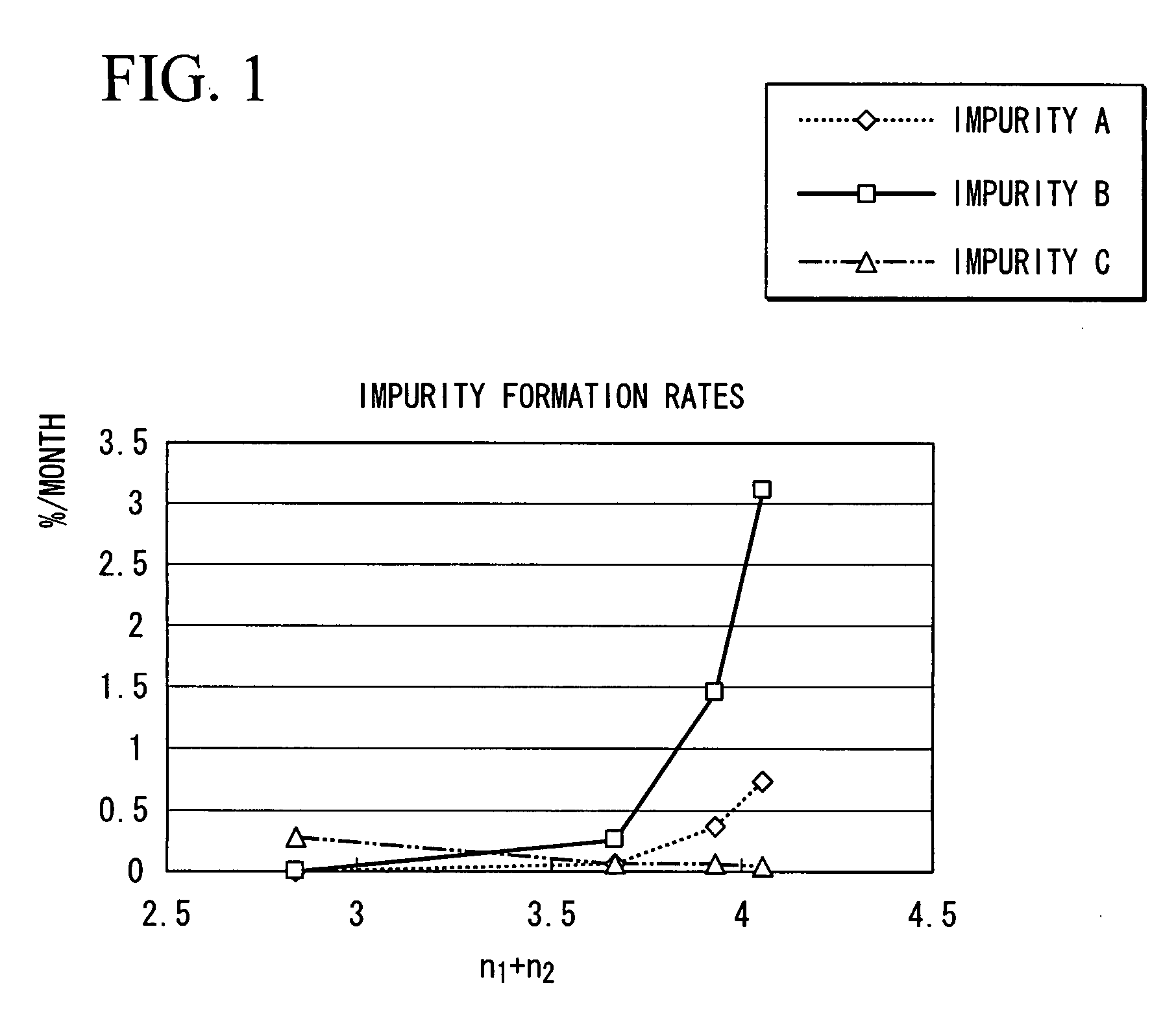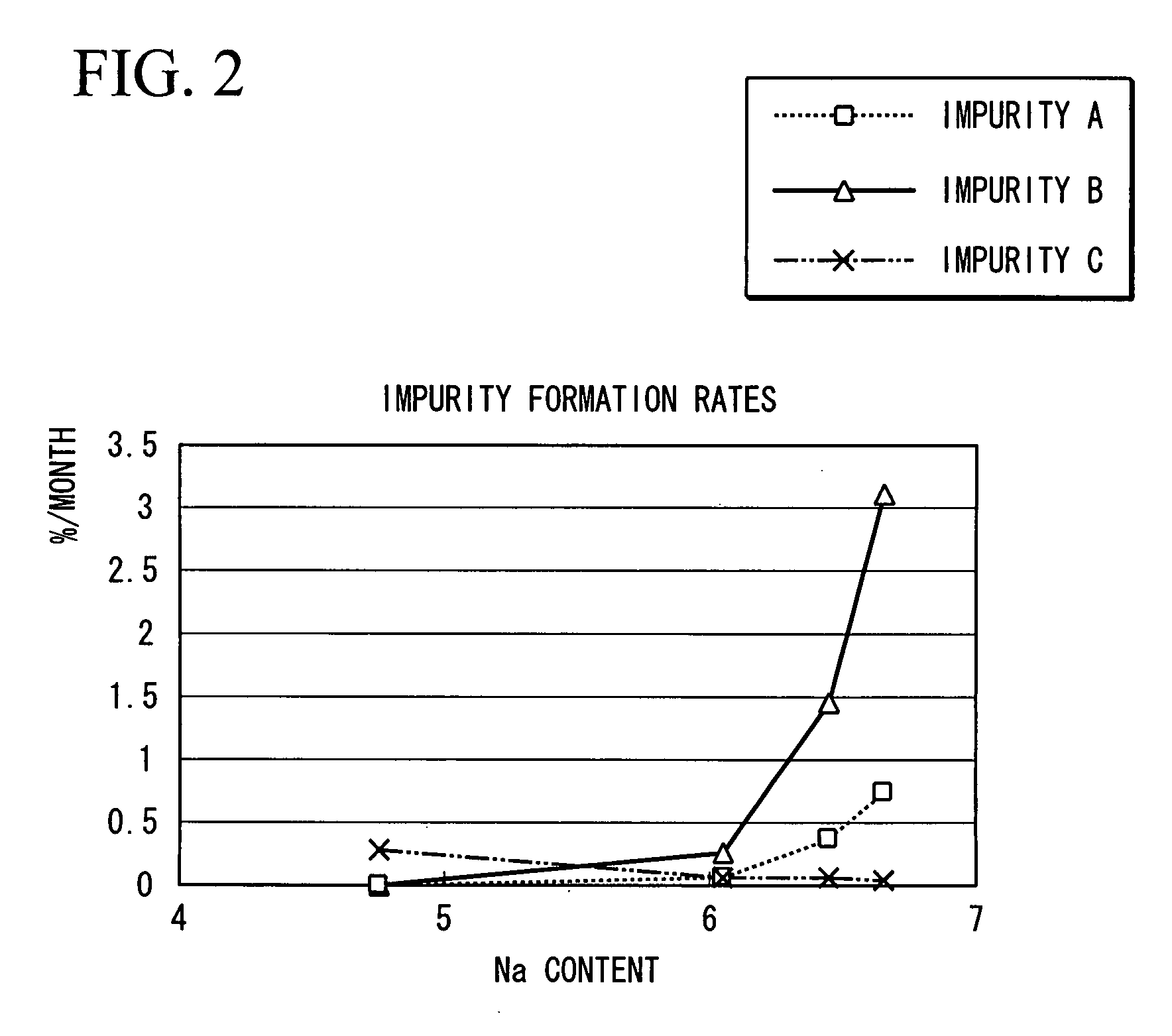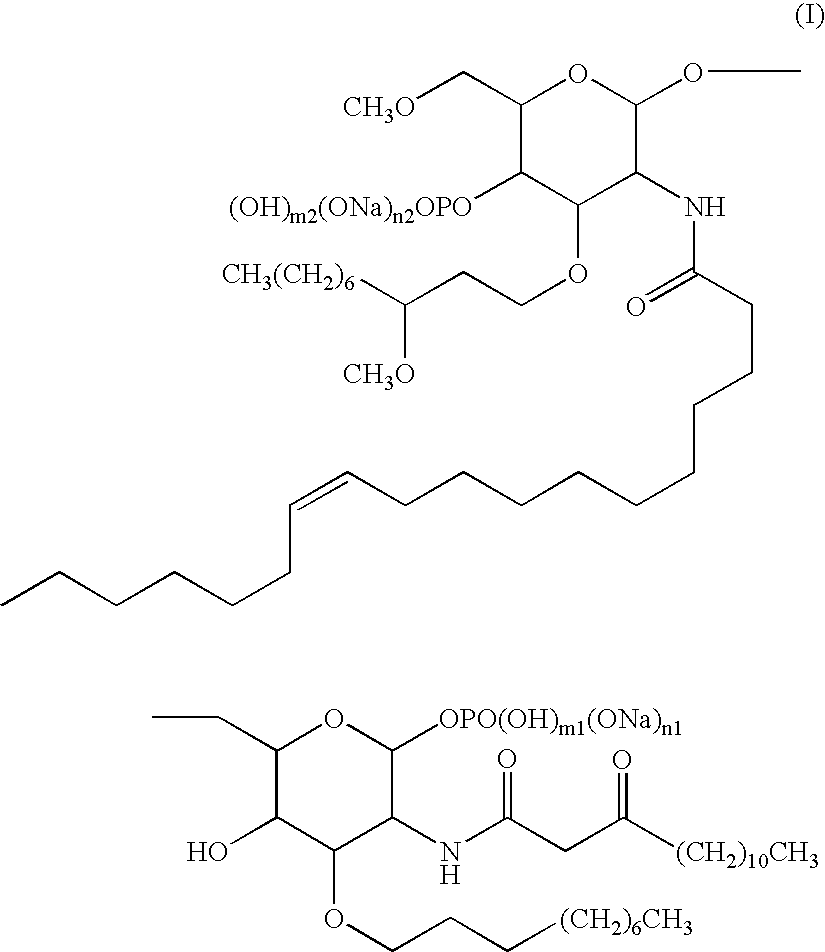Sodium salt of disaccharide compound, production method and use of same
a technology of disaccharide compound and production method, which is applied in the field of sodium salt of disaccharide compound, can solve the problems of trace amounts of impurities, tetrasodium salts of aforementioned compound have recently been found to slightly decompose during storage, and achieve superior safety as a pharmaceutical, reduce the formation of impurities, and improve the effect of safety
- Summary
- Abstract
- Description
- Claims
- Application Information
AI Technical Summary
Benefits of technology
Problems solved by technology
Method used
Image
Examples
reference example 1
Synthesis of α-D-glucopyranose, (1Z)-1-propenyl 2-deoxy-3-O-[(3R)-3-methoxydecyl]-6-O-methyl-2-[[(11Z)-1-oxo-11-octadecenyl]amino]-, 4-(di-2-propenylphosphate)
[0085]
[0086]235 g of α-D-Glucose, (1Z)-1-propenyl 2-deoxy-3-O-[(3R)-3-methoxydecyl]-6-O-methyl-2-[[(11Z)-1-oxo-11-octadecenyl]amino]- [CAS registration no.: 748165-17-5] were dissolved in 933 mL of toluene in a 2 L 4-way flask followed by sequentially dropping in 129 mL of diallyl-N,N-diisopropylphosphoramidate, 39.4 mL of pyridine and 36.3 mL of trifluoroacetic acid at room temperature. 1.5 hours after completion of dropping, the reaction liquid was cooled to −20° C. and dilute acetonitrile solution (933 mL) containing 47.5 mL of hydrogen peroxide were was dropped in over the course of 37 minutes. Following completion of dropping, the reaction liquid was heated to 10° C. over the course of 40 minutes. Three hours later, the reaction liquid was quenched by adding 940 mL of 5% aqueous sodium bisulfite solution and then heated t...
reference example 2
Synthesis of α-D-Glucose, 2-Deoxy-3-O-[(3R)-3-methoxydecyl]-6-O-methyl-2-[[(11Z)-1-oxo-11-octadecenyl]amino]-, 4-(di-2-propenylphosphate)
[0087]
[0088]The α-D-glucopyranose, (1Z)-1-propenyl 2-deoxy-3-O-[(3R)-3-methoxydecyl]-6-O-methyl-2-[[(11Z)-1-oxo-11-octadecenyl]amino]-, 4-(di-2-propenylphosphate) solution obtained in Reference Example 1 was washed with 699 mL of 1 N aqueous hydrochloric acid followed by the addition of 27.9 mL of 5 N aqueous hydrochloric acid and stirring for 5 hours at room temperature. After neutralizing with 699 mL of 5% aqueous sodium bicarbonate, the solution was separated with ethyl acetate and the organic layer was washed with 699 mL of 5% saline solution. After drying by adding 69.9 g of anhydrous magnesium sulfate, the solution was filtered and the filtrate was concentrated under reduced pressure. 466 mL of acetone were added to the residue followed by again concentrating under reduced pressure. This acetone treatment was repeated to obtain 289.1 g of a c...
reference example 3
Synthesis of α-D-glucopyranose, 2-deoxy-3-O-[(3R)-3-methoxydecyl]-6-O-methyl-2-[[(11Z)-1-oxo-11-octadecenyl]amino]-, 4-(di-2-propenylphosphate) 1-(2,2,2-trichloroethaneimidate)
[0090]
[0091]280 g of α-D-glucose, 2-deoxy-3-O-[(3R)-3-methoxydecyl]-6-O-methyl-2-[[(11Z)-1-oxo-11-octadecenyl]amino]-, 4-(di-2-propenylphosphate), 46.8 g of potassium carbonate, 560 mL of methyl acetate, 170 mL of trichloroacetonitrile and 8.4 mL of water were added to a 2 L 4-way flask followed by stirring for 2 hours at 0° C. in the presence of a nitrogen atmosphere. The reaction liquid was filtered with celite and concentrated under reduced pressure at 40° C. Continuing, the concentrate was co-boiled three times with 560 mL of heptane to obtain 432 g of the target compound (content: 63.9%, containing 171.4 mL of heptane). Yield: 87.5%.
PUM
| Property | Measurement | Unit |
|---|---|---|
| reaction time | aaaaa | aaaaa |
| reaction time | aaaaa | aaaaa |
| temperature | aaaaa | aaaaa |
Abstract
Description
Claims
Application Information
 Login to View More
Login to View More - R&D
- Intellectual Property
- Life Sciences
- Materials
- Tech Scout
- Unparalleled Data Quality
- Higher Quality Content
- 60% Fewer Hallucinations
Browse by: Latest US Patents, China's latest patents, Technical Efficacy Thesaurus, Application Domain, Technology Topic, Popular Technical Reports.
© 2025 PatSnap. All rights reserved.Legal|Privacy policy|Modern Slavery Act Transparency Statement|Sitemap|About US| Contact US: help@patsnap.com



